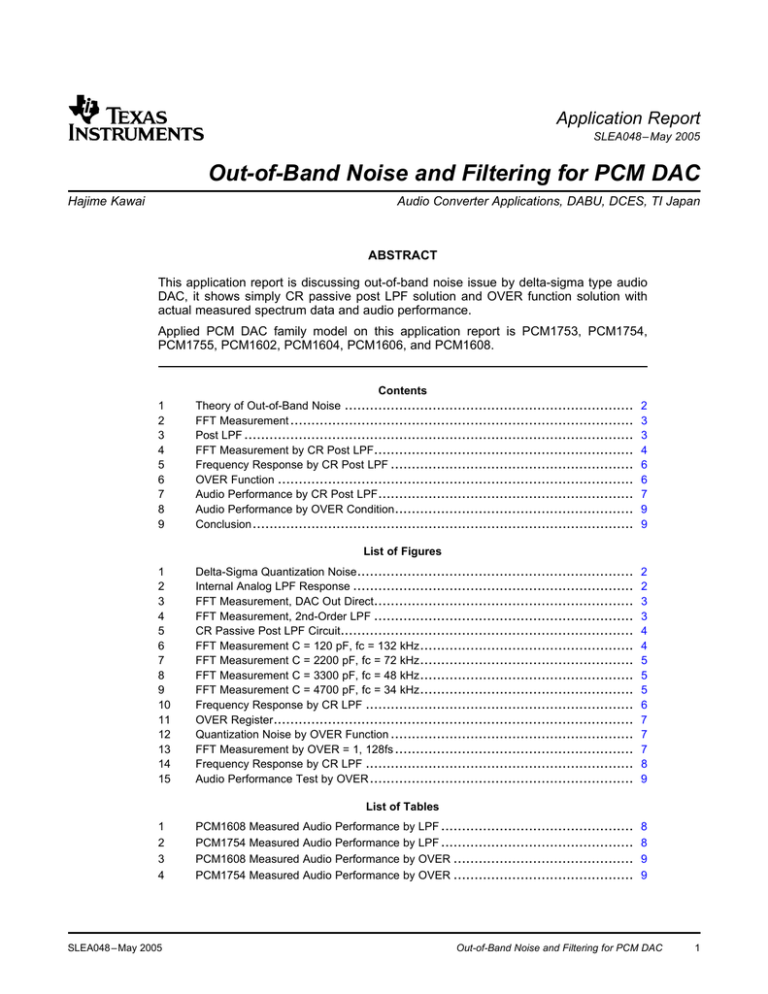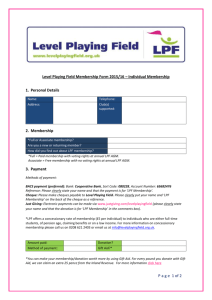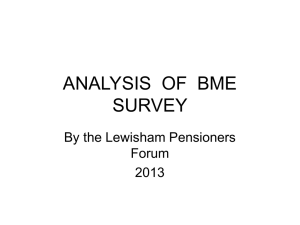Out-of-Band Noise and Filtering for PCM DAC
advertisement

Application Report SLEA048 – May 2005 Out-of-Band Noise and Filtering for PCM DAC Hajime Kawai .......................................................... Audio Converter Applications, DABU, DCES, TI Japan ABSTRACT This application report is discussing out-of-band noise issue by delta-sigma type audio DAC, it shows simply CR passive post LPF solution and OVER function solution with actual measured spectrum data and audio performance. Applied PCM DAC family model on this application report is PCM1753, PCM1754, PCM1755, PCM1602, PCM1604, PCM1606, and PCM1608. 1 2 3 4 5 6 7 8 9 Contents Theory of Out-of-Band Noise ..................................................................... FFT Measurement .................................................................................. Post LPF ............................................................................................. FFT Measurement by CR Post LPF.............................................................. Frequency Response by CR Post LPF .......................................................... OVER Function ..................................................................................... Audio Performance by CR Post LPF ............................................................. Audio Performance by OVER Condition ......................................................... Conclusion ........................................................................................... 2 3 3 4 6 6 7 9 9 List of Figures 1 2 3 4 5 6 7 8 9 10 11 12 13 14 15 Delta-Sigma Quantization Noise.................................................................. Internal Analog LPF Response ................................................................... FFT Measurement, DAC Out Direct.............................................................. FFT Measurement, 2nd-Order LPF .............................................................. CR Passive Post LPF Circuit...................................................................... FFT Measurement C = 120 pF, fc = 132 kHz ................................................... FFT Measurement C = 2200 pF, fc = 72 kHz ................................................... FFT Measurement C = 3300 pF, fc = 48 kHz ................................................... FFT Measurement C = 4700 pF, fc = 34 kHz ................................................... Frequency Response by CR LPF ................................................................ OVER Register...................................................................................... Quantization Noise by OVER Function .......................................................... FFT Measurement by OVER = 1, 128fs ......................................................... Frequency Response by CR LPF ................................................................ Audio Performance Test by OVER ............................................................... 2 2 3 3 4 4 5 5 5 6 7 7 7 8 9 List of Tables 1 2 3 4 SLEA048 – May 2005 PCM1608 PCM1754 PCM1608 PCM1754 Measured Measured Measured Measured Audio Audio Audio Audio Performance by Performance by Performance by Performance by LPF .............................................. LPF .............................................. OVER ........................................... OVER ........................................... 8 8 9 9 Out-of-Band Noise and Filtering for PCM DAC 1 www.ti.com Theory of Out-of-Band Noise 1 Theory of Out-of-Band Noise Figure 1 shows quantization noise spectrum of the delta-sigma modulator section of the applied PCM DAC family model. The delta-sigma modulator is operated by 64fs sampling rate in default condition (fs: normalized sampling frequency). Quantization noise level in audio band, up to fs/2, is low level, it can achieves specified 107-dB dynamic range. Otherwise, quantization noise level from fs/2 to 8fs frequency band is around –60 dBFS, this application report defines it as out-of-band noise. This quantization noise spectrum performance is given by designing of delta-sigma modulator, DAC family in this case uses 4th-order, 8-level quantizer delta-sigma modulator. This quantization noise is converted to analog signal, then, thorough internal analog LPF of DAC. Figure 2 shows frequency response of DAC internal analog LPF, it has 100-kHz pass bandwidth, noise spectrum from fs/2 to fs band could not removed. Therefore, DAC outputs converted audio signal with out-of-band noise which is given as total performance of delta-sigma quantization noise and internal analog LPF performance. Amplitude (dB) QUANTIZATION NOISE SPECTRUM (64x Oversampling) Frequency (fs) 2/fs : Audio band 100KHz/fs=48KHz Level (dB) Figure 1. Delta-Sigma Quantization Noise −3dB at 100KHz Log Frequency (Hz) Figure 2. Internal Analog LPF Response 2 Out-of-Band Noise and Filtering for PCM DAC SLEA048 – May 2005 www.ti.com FFT Measurement 2 FFT Measurement Figure 3 shows 100-kHz bandwidth FFT spectrum data by DAC output direct. Measurement condition is: –60-dBFS, 1-kHz sine wave signal fs = 48 kHz, 64fs (default) It shows around –82 dB level out-of-band noise at 100 kHz. Figure 4 shows 100-kHz bandwidth FFT spectrum data with 2nd-order post LPF. Measurement condition is same as above. It shows around –92 dB level out-of-band noise at 100-kHz, it is 10 dB lower than direct output. 1KHz −60dB −82dB at 100KHz Figure 3. FFT Measurement, DAC Out Direct 1KHz −60dB −92dB at 100KHz Figure 4. FFT Measurement, 2nd-Order LPF 3 Post LPF In general applications, this out-of-band noise can be removed by active type 2nd-order or 3rd-oder post LPF which have around 40-kHz to 80-kHz cut-off frequency performance as shown in Figure 4. Typical application circuit of post LPF is shown in each data sheet, almost application uses 2nd-order post LPF with gain amp function to achieves 2-Vrms CD/DVD standard line output level. In case of cost sensitive applications, even a dual OpAmp IC for stereo post LPF should be considered to save material cost of application. SLEA048 – May 2005 Out-of-Band Noise and Filtering for PCM DAC 3 www.ti.com FFT Measurement by CR Post LPF But, out-of-band noise should be removed to avoid any nonestimated operation of connected analog amp section such as inter-modulated noise in audio band, one of solution for this issue is simply CR passive post LPF. Figure 5 shows an application circuit for post LPF by simply CR passive filter. Cut-off frequency fc is given by fc = 1/ 2π C2R1 (Hz) CR LPF PCM DAC 10uF R1 VOUTx VOUT (FFT measurement) C2 VCOM 10uF R1 = 1K C2 = 1200pF / fc= 132KHz 2200pF / fc=72KHz 3300pF / fc=48KHz 4700pF / fc=34KHz Figure 5. CR Passive Post LPF Circuit 4 FFT Measurement by CR Post LPF Figure 6, Figure 7, Figure 8, and Figure 9 shows 100-kHz bandwidth FFT measurement data by four type CR passive post LPF. Removed noise level at 100 kHz is 2 dB to 8 dB, but, it is better than DAC output direct, without any post LPF. 1KHz, −60dB −84dB at 100KHz Figure 6. FFT Measurement C = 120 pF, fc = 132 kHz 4 Out-of-Band Noise and Filtering for PCM DAC SLEA048 – May 2005 www.ti.com FFT Measurement by CR Post LPF 1KHz, −60dB −86dB at 100KHz Figure 7. FFT Measurement C = 2200 pF, fc = 72 kHz 1KHz, −60dB −88dB at 100KHz Figure 8. FFT Measurement C = 3300 pF, fc = 48 kHz 1KHz, −60dB −90dB at 100KHz Figure 9. FFT Measurement C = 4700 pF, fc = 34 kHz SLEA048 – May 2005 Out-of-Band Noise and Filtering for PCM DAC 5 www.ti.com Frequency Response by CR Post LPF 5 Frequency Response by CR Post LPF On the other hands, audio band signal frequency response should be considered so that CR passive LPF have slow roll-off characteristics for audio band. In general, –1 dB or –0.5 dB frequency response at 20 kHz is required. Figure 10 shows frequency response by four type CR post LPF and DAC direct. D−A THD+N Amplitude vs Signal Amplitude +1 +0 . 5 +0 −0 . 5 −1 d B r −1 . 5 A −2 −2 . 5 −3 −3 . 5 −4 0 2k 4k 6k 8k 10 k 12 k 14 k 16 k 18 k 20 k Hz Sweep Trace 1 2 3 4 5 1 1 1 1 1 Color Line Style Green Yellow Red Magenta Blue Solid Solid Solid Solid Solid Thick 1 1 1 1 1 Data Axis Comment Anlr.Level A Anlr.Level A Anlr.Level A Anlr.Level A Anlr.Level A Left Left Left Left Left Vout Direct C=1200pF(fc=132kHz) C=2200pF(fc=72kHz) C=3300pF(fc=48kHz) C=4700pF(fc=34kHz) Figure 10. Frequency Response by CR LPF 6 OVER Function Software control (serial register control) DAC family have OVER function, this OVER is selectable function for operating sampling rate, fs of delta-sigma section. Figure 11 shows register MAP by PCM1608 for OVER function. Default operating is 64fs (OVER = 0). Otherwise, this operation can be switched to 128fs by setting OVER = 1, then boost frequency of quantization noise can be shifted to more higher frequency as shown in Figure 12. Figure 13 shows 100-kHz bandwidth FFT measurement by DAC output direct. As you can see from FFT data on Figure 13, out-of-band noise up to 100 kHz could be much improved around -102 dB at 100 kHz by operation of OVER = 1. 6 Out-of-Band Noise and Filtering for PCM DAC SLEA048 – May 2005 www.ti.com Audio Performance by CR Post LPF FUNCTION RESET DEFAULT REGISTER BIT(s) Digital attenuation control, 0 dB to -63 dB in 0.5 dB steps 0 dB, no attenuation 16 and 17 AT1[7:0], AT2[7:0] Mute disabled 18 MUT[2:0] 64fs oversampling 18 OVER Soft mute control Oversampling rate control (64fs or 128fs) System Clock Rate = 256, 384, 512, or 768 fs: Over = 0 Over = 1 64x Oversampling (default 128x Oversampling Figure 11. OVER Register OVER=0 x64fs OVER=1 x128fs −120 −120 −140 −140 −160 −160 −180 −180 0 1 2 0 1 2 Figure 12. Quantization Noise by OVER Function −60dB Direct Output by OVER=1, x128fs ( without LPF) 1KHz −60dB −102dB at 100KHz Figure 13. FFT Measurement by OVER = 1, 128fs 7 Audio Performance by CR Post LPF Key audio performance is THD+N, Dynamic Range, and SNR in typical digital audio application, this section shows actual measured key audio performance by post LPF condition. Figure 14 shows test block diagram for audio performance measurement, it uses Audio Precision AP2722 with AES-17 LPF. SLEA048 – May 2005 Out-of-Band Noise and Filtering for PCM DAC 7 www.ti.com Audio Performance by CR Post LPF AES-17 LPF in AP2722 is 20-kHz band limit filter, it have –60-dB attenuation at f = 24 kHz, any out-of-band noise can be removed ideally. Table 1 shows actual measured audio performance of the PCM1608 (as typical model of multi-channel DAC family) by two post LPF condition. Table 2 shows actual measured audio performance of the PCM1754 (as typical model of 2ch DAC) by two post LPF condition. Both test result says that audio performance is not influenced by post LPF type condition with 20-kHz band limit by AES-17 LPF for testing. 2nd−order Active LPF (EVM) S/PDIF PCM DAC VOUT VIN S/PDIF PCM DAC CR passive LPF (1K, 2200pF) AP AP2722 (AES−17 LPF ON) VOUT S/PDIF Figure 14. Frequency Response by CR LPF Table 1. PCM1608 Measured Audio Performance by LPF Performance/LPF 2nd LPF CR LPF VOUT, Lch 2.013 V 1.091 V VOUT, Rch 2.014 V 1.094 V% THD+N, Lch 0.00157% 0.00151% THD+N, Rch 0.00182% 0.00189% D.Range, Lch 103.6 dB 104.1 dB D.Range, Rch 103.8 dB 104.3 dB SNR, Lch 103.8 dB 104.2 dB SNR, Rch 103.9 dB 104.5 dB Table 2. PCM1754 Measured Audio Performance by LPF Performance/LPF 8 2nd Active LPF CR Passive LPF VOUT, Lch 2.58 V 1.41 V VOUT, Rch 2.59 V 1.41 V THD+N, Lch 0.00288% 0.00297% THD+N, Rch 0.00283% 0.00301% D.Range, Lch 104.7 dB 105.2 dB D.Range, Rch 104.7 dB 105.1 dB SNR, Lch 106.7 dB 107.2 dB SNR, Rch 107.0 dB 107.5 dB Out-of-Band Noise and Filtering for PCM DAC SLEA048 – May 2005 www.ti.com Audio Performance by OVER Condition 8 Audio Performance by OVER Condition OVER function is effective to remove out-of-band noise up to 100 kHz, but, operation speed at OVER = 1 is 128fs, switching speed for DAC internal circuit would be double, then, it makes higher noise over default 64fs operation. This section shows audio performance difference by OVER function. Figure 15 shows test block diagram for audio performance measurement, it is almost same as Figure 14. Table 3 shows actual measured audio performance of the PCM1608 by OVER = 0, 1. Table 4 shows actual measured audio performance of the PCM1754 by OVER = 0, 1. In case of operation by OVER = 1, there is very small performance degrading over OVER = 0. S/PDIF DEM−DAI160x, 175x (with LPF) VOUT AP AP2722 (AES−17 LPF ON) OVER (64fs, 128fs) Figure 15. Audio Performance Test by OVER Table 3. PCM1608 Measured Audio Performance by OVER Performance/OVER 64fs 128fs THD+N, Lch [%] 0.00138 0.00177 THD+N, Rch [%] 0.00168 0.0028 D.Range, Lch [dB] 104.8 103.0 D.Range, Rch [dB] 104.9 104.1 SNR, Lch [dB] 104.8 104.8 SNR, Rch [dB] 105.0 104.9 Table 4. PCM1754 Measured Audio Performance by OVER Performance/OVER 9 64fs 128fs THD+N, Lch [%] 0.00229 0.00278 THD+N, Rch [%] 0.00241 0.00297 D.Range, Lch [dB] 106.5 105.9 D.Range, Rch [dB] 106.5 106.0 SNR, Lch [dB] 107.7 107.2 SNR, Rch [dB] 108.1 107.6 Conclusion Acceptable out-of-band noise level is depends on application, this report shows a couple of solution with actual measured data. In general applications, to remove out-of-band noise: SLEA048 – May 2005 Out-of-Band Noise and Filtering for PCM DAC 9 www.ti.com Conclusion • • • 10 2nd-order active post LPF is recommended. Simply CR passive post LPF is one of solution without any performance degrading. OVER = 1 (128fs) function can be much removed out-of-band noise. Out-of-Band Noise and Filtering for PCM DAC SLEA048 – May 2005 IMPORTANT NOTICE Texas Instruments Incorporated and its subsidiaries (TI) reserve the right to make corrections, modifications, enhancements, improvements, and other changes to its products and services at any time and to discontinue any product or service without notice. Customers should obtain the latest relevant information before placing orders and should verify that such information is current and complete. All products are sold subject to TI’s terms and conditions of sale supplied at the time of order acknowledgment. TI warrants performance of its hardware products to the specifications applicable at the time of sale in accordance with TI’s standard warranty. Testing and other quality control techniques are used to the extent TI deems necessary to support this warranty. Except where mandated by government requirements, testing of all parameters of each product is not necessarily performed. TI assumes no liability for applications assistance or customer product design. Customers are responsible for their products and applications using TI components. To minimize the risks associated with customer products and applications, customers should provide adequate design and operating safeguards. TI does not warrant or represent that any license, either express or implied, is granted under any TI patent right, copyright, mask work right, or other TI intellectual property right relating to any combination, machine, or process in which TI products or services are used. Information published by TI regarding third-party products or services does not constitute a license from TI to use such products or services or a warranty or endorsement thereof. Use of such information may require a license from a third party under the patents or other intellectual property of the third party, or a license from TI under the patents or other intellectual property of TI. Reproduction of information in TI data books or data sheets is permissible only if reproduction is without alteration and is accompanied by all associated warranties, conditions, limitations, and notices. Reproduction of this information with alteration is an unfair and deceptive business practice. TI is not responsible or liable for such altered documentation. Resale of TI products or services with statements different from or beyond the parameters stated by TI for that product or service voids all express and any implied warranties for the associated TI product or service and is an unfair and deceptive business practice. TI is not responsible or liable for any such statements. Following are URLs where you can obtain information on other Texas Instruments products and application solutions: Products Applications Amplifiers amplifier.ti.com Audio www.ti.com/audio Data Converters dataconverter.ti.com Automotive www.ti.com/automotive DSP dsp.ti.com Broadband www.ti.com/broadband Interface interface.ti.com Digital Control www.ti.com/digitalcontrol Logic logic.ti.com Military www.ti.com/military Power Mgmt power.ti.com Optical Networking www.ti.com/opticalnetwork Microcontrollers microcontroller.ti.com Security www.ti.com/security Telephony www.ti.com/telephony Video & Imaging www.ti.com/video Wireless www.ti.com/wireless Mailing Address: Texas Instruments Post Office Box 655303 Dallas, Texas 75265 Copyright 2005, Texas Instruments Incorporated



